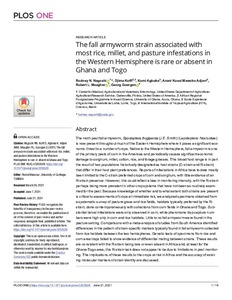| dc.contributor.author | Nagoshi, R.N. |
| dc.contributor.author | Koffi, D. |
| dc.contributor.author | Agboka, K. |
| dc.contributor.author | Adjevi, A.K.M. |
| dc.contributor.author | Meagher, R.L. |
| dc.contributor.author | Goergen, G. |
| dc.date.accessioned | 2021-10-13T08:48:28Z |
| dc.date.available | 2021-10-13T08:48:28Z |
| dc.date.issued | 2021 |
| dc.identifier.citation | Nagoshi, R.N., Koffi, D., Agboka, K., Adjevi, A.K.M., Meagher, R.L. & Goergen, G. (2021). The fall armyworm strain associated with most rice, millet, and pasture infestations in the Western Hemisphere is rare or absent in Ghana and Togo. Plos One, 16(6), e0253528: 1-16. |
| dc.identifier.issn | 1932-6203 |
| dc.identifier.uri | https://hdl.handle.net/20.500.12478/7268 |
| dc.description.abstract | The moth pest fall armyworm, Spodoptera frugiperda (J.E. Smith) (Lepidoptera: Noctuidae) is now present throughout much of the Eastern Hemisphere where it poses a significant economic threat to a number of crops. Native to the Western Hemisphere, fall armyworm is one of the primary pests of corn in the Americas and periodically causes significant economic damage to sorghum, millet, cotton, rice, and forage grasses. This broad host range is in part the result of two populations historically designated as host strains (C-strain and R-strain) that differ in their host plant preferences. Reports of infestations in Africa have to date mostly been limited to the C-strain preferred crops of corn and sorghum, with little evidence of an R-strain presence. However, this could reflect a bias in monitoring intensity, with the R-strain perhaps being more prevalent in other crop systems that have not been as routinely examined for the pest. Because knowledge of whether and to what extent both strains are present is critical to assessments of crops at immediate risk, we analyzed specimens obtained from a systematic survey of pasture grass and rice fields, habitats typically preferred by the R-strain, done contemporaneously with collections from corn fields in Ghana and Togo. Substantial larval infestations were only observed in corn, while pheromone trap capture numbers were high only in corn and rice habitats. Little to no fall armyworm were found in the pasture setting. Comparisons with a meta-analysis of studies from South America identified differences in the pattern of strain-specific markers typically found in fall armyworm collected from rice habitats between the two hemispheres. Genetic tests of specimens from rice and corn area traps failed to show evidence of differential mating between strains. These results are consistent with the R-strain being rare or even absent in Africa and, at least for the Ghana-Togo area, this R-strain lack does not appear to be due to limitations in pest monitoring. The implications of these results to the crops at risk in Africa and the accuracy of existing molecular markers of strain identity are discussed. |
| dc.format.extent | 1-16 |
| dc.language.iso | en |
| dc.subject | Spodoptera Frugiperda |
| dc.subject | Food Crops |
| dc.subject | Forage |
| dc.subject | Dna |
| dc.subject | Strain Differences |
| dc.title | The fall armyworm strain associated with most rice, millet, and pasture infestations in the Western Hemisphere is rare or absent in Ghana and Togo |
| dc.type | Journal Article |
| cg.contributor.affiliation | United States Department of Agriculture- Agricultural Research Service |
| cg.contributor.affiliation | University of Ghana |
| cg.contributor.affiliation | Universite de Lome |
| cg.contributor.affiliation | International Institute of Tropical Agriculture |
| cg.coverage.region | Africa |
| cg.coverage.region | West Africa |
| cg.coverage.country | Ghana |
| cg.coverage.country | Togo |
| cg.coverage.hub | Headquarters and Western Africa Hub |
| cg.researchtheme | Plant Production and Health |
| cg.identifier.bibtexciteid | NAGOSHI:2021 |
| cg.isijournal | ISI Journal |
| cg.authorship.types | CGIAR and developing country institute |
| cg.iitasubject | Agronomy |
| cg.iitasubject | Disease Control |
| cg.iitasubject | Food Security |
| cg.iitasubject | Plant Breeding |
| cg.iitasubject | Plant Diseases |
| cg.iitasubject | Plant Health |
| cg.iitasubject | Plant Production |
| cg.journal | PLOS ONE |
| cg.notes | Open Access Journal; Published online: 21 June 2021 |
| cg.accessibilitystatus | Open Access |
| cg.reviewstatus | Peer Review |
| cg.usagerightslicense | Creative Commons Attribution 4.0 (CC BY 0.0) |
| cg.targetaudience | Scientists |
| cg.identifier.doi | https://dx.doi.org/10.1371/journal.pone.0253528 |
| cg.iitaauthor.identifier | Georg Goergen: 0000-0003-4496-0495 |
| cg.futureupdate.required | No |
| cg.identifier.issue | 6: e0253528 |
| cg.identifier.volume | 16 |
| cg.contributor.acknowledgements | We recognize Dr. J.M.G. Thomas for technical assistance in preparing the specimens. The use of trade, firm, or corporation names in this publication is for the information and convenience of the reader. Such use does not constitute an official endorsement or approval by the United States Department of Agriculture or the Agricultural Research Service of any product or service to the exclusion of others that may be suitable. |

